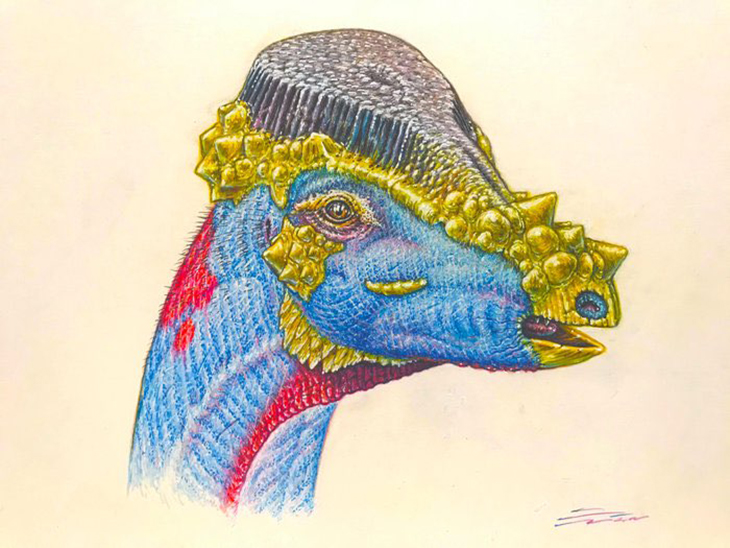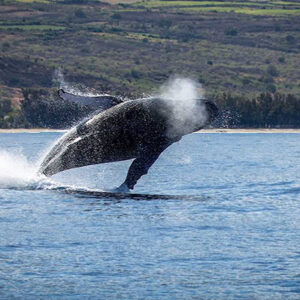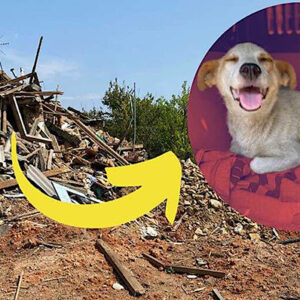
Researchers have discovered an intriguing piece of dinosaur history that sheds light on the appearance of these prehistoric creatures. A fossilized skull of the Platytholus Clemensi, a plant-eating dinosaur from the pachycephalosaur family, was recently found in Montana’s Hell Creek Formation.
According to researchers, this remarkable find unveiled traces of keratin bristles, akin to those found in modern-day fingernails and rhino horns, protruding from its skull, imparting the dinosaur with a distinct “brush cut” look.
Measuring up to 15 feet in length and walking on two legs, the Platytholus Clemensi belongs to a rather diverse group of dinosaurs that are known for their striking cranial adornments. These adornments usually range from a variation of horns, such as that of the Triceratops, to the crests of hadrosaurs, or even the bony knobs found on that of the Tyrannosaurus Rex.
Researchers discovered a partially healed gash on the head of the pachycephalosaur, and they believed that he probably engaged in some head-to-head combat during courtship rituals. However, they also said that there is no conclusive evidence to support their theory. Rather, experts now believe that the keratin bristles are more of an ornate headdress than they are a tool for physical confrontation.
Dr. Mark Goodwin of the University of California, Berkeley, said, “We don’t know the exact shape of what was covering the dome, but it had this vertical component that we interpret as covered with keratin. A bristly, flat-topped covering biologically makes sense. Animals change or use certain features, particularly on the skull, for multiple functions.”
The wound that they saw on the head was around half an inch deep, however, it could have been caused by something else like a falling rock, a tree, or possibly even another dinosaur.
“We see probably the first unequivocal evidence of trauma in the head of any pachycephalosaur, where the bone was actually ejected from the dome somehow and healed partially in life. We don’t know how that was caused. It could be head-butting—we don’t dispute that,” said Dr. Goodwin.
As for Dr. Goodwin’s colleague and co-author of the paper talking about the dinosaur, Dr. John Horner at the University of California, Orange, believes that because the Dinosaurs’ closest relative is the bird, they should take a closer look at the skill ornamentation among them instead of their distant lizard precursors, to see what the actual purpose of these bristles was.
Dr. Horner said, “That’s the first place everybody wants to go—let’s crash them together. And, you know, we just don’t see any evidence of it, histologically. Any features, any accoutrements that we find on the heads of dinosaurs, I think, are all display—it’s all about display.”
He also said that reptiles and birds, as mentioned earlier, happen to be the closest relatives to dinosaurs. And while they have similar head ornamentation for display, they hardly ever butt heads in the same way that other mammals – such as sheep – do. And while crocodiles may bash their heads together during mating and territorial disputes, for hours at a time, dinosaurs diverged from crocodiles over 200 million years before this animal even came to be.
Notably, Pachycephalosaurs lack a pneumatic chamber above their braincase, just like that of bighorn sheep, which also protects their brain from injury.
“I don’t see any reason to turn dinosaurs into mammals, rather than just trying to figure out what they might be doing as bird-like reptiles,” Dr. Horner said.
The study, published in the Journal of Vertebrate Paleontology, revealed that blood vessels in the dinosaur’s skull led to the surface of its dome, indicating that they nourished some tissue atop the structure. Perpendicular to the surface, these vessels likely supported a vertical structure that might have been high and possibly colored, potentially varying with the seasons.
Such ornamental features could have been used for sexual display and courtship, and possibly for nudging the flanks rather than the heads of male rivals.
Horner continued, “What we see are these vertical canals coming to the surface, which suggests that there might be keratin on top, but it’s oriented vertically.”
“I think these pachycephalosaurs had something on top of their head that we don’t know about. I don’t think they were just domes. I think there was some elaborate display on top of their head,” he added.
Dr. Goodwin speculates that, like many modern birds, dinosaurs might have distinguished gender through coloration around the face and head, facilitating visual communication. This discovery opens up exciting new possibilities for understanding the behaviors and appearance of ancient dinosaurs, giving us a glimpse into their captivating world of ornamental displays and communication.
What are your thoughts? Please comment below and share this news!
True Activist / Report a typo


